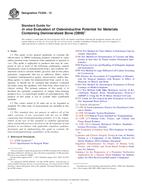We need your consent to use the individual data so that you can see information about your interests, among other things. Click "OK" to give your consent.
ASTM F2529-13
Standard Guide for in vivo Evaluation of Osteoinductive Potential for Materials Containing Demineralized Bone (DBM)
STANDARD published on 1.2.2013
The information about the standard:
Designation standards: ASTM F2529-13
Note: WITHDRAWN
Publication date standards: 1.2.2013
SKU: NS-54073
The number of pages: 16
Approximate weight : 48 g (0.11 lbs)
Country: American technical standard
Category: Technical standards ASTM
The category - similar standards:
Other standards related to laboratory medicineBiology. Botany. Zoology
Annotation of standard text ASTM F2529-13 :
Keywords:
animal model, athymic, bioassay, demineralized bone, osteoconductive, osteoinductive, ICS Number Code 07.080 (Biology. Botany. Zoology),11.100.99 (Other standards related to laboratory medicine)
Additional information
| Significance and Use | ||||||||||||||||||||||||||||||||||||||||||
|
4.1 This guide covers animal implantation methods and analysis of the explanted DBM-containing material to determine whether a material or substance possesses osteoinductive potential, as defined by its ability to cause bone to form 4.2 The test methods described here may be suitable for defining product specifications, cGMP lot release testing, research evaluation, regulatory submission, and so forth, but a positive outcome should not be presumed to indicate that the product will be osteoinductive in a human clinical application. At present, the only direct assays to assess new bone formation are in vivo, since the property of bone conduction or induction can only be assessed in a heterotopic or orthotopic site in a living animal. When these products are implanted in an orthotopic site, osteogenic factors already present at the implantation site may contribute to and enhance bone formation in conjunction with the osteoconductive nature of the product. Thus, orthotopic implantation of products may result in bone formation by acting on existing bone forming cells and not by causing mesenchymal stem cells to become osteochondroprogenitor cells. In contrast, when these products are implanted in a heterotopic site, no native osteogenic factors are present to contribute to or enhance bone formation. Thus, heterotopic implantation of products will only result in new bone formation by causing mesenchymal stem cells to become osteochondroprogenitor cells. In vitro assays have been described and some believe they may correlate to the results obtained from in vivo assays. However such 1.1 This guide covers general guidelines to evaluate the effectiveness of DBM-containing products intended to cause and/or promote bone formation when implanted or injected 1.2 The values stated in SI units are to be regarded as standard. No other units of measurement are included in this standard. 1.3 This standard does not purport to address all of the safety concerns, if any, associated with the use of DBM-containing bone-forming/promoting products. It is the responsibility of the user of this standard to establish appropriate safety and health practices involved in the development of said products in accordance with applicable regulatory guidance documents and in implementing this guide to evaluate the bone-forming/promoting capabilities of the product. |
||||||||||||||||||||||||||||||||||||||||||
| 2. Referenced Documents | ||||||||||||||||||||||||||||||||||||||||||
|
Similar standards:
Historical
1.4.2012
Historical
1.3.2011
Historical
1.3.2014
Historical
1.5.2014
Historical
1.5.2014
Historical
1.1.2010
We recommend:
Technical standards updating
Do you want to make sure you use only the valid technical standards?
We can offer you a solution which will provide you a monthly overview concerning the updating of standards which you use.
Would you like to know more? Look at this page.



 ASTM F2884-12
ASTM F2884-12 ASTM F2903-11
ASTM F2903-11 ASTM F2952-14
ASTM F2952-14 ASTM F3088-14
ASTM F3088-14 ASTM F3089-14
ASTM F3089-14 ASTM F997-10
ASTM F997-10
 Cookies
Cookies
